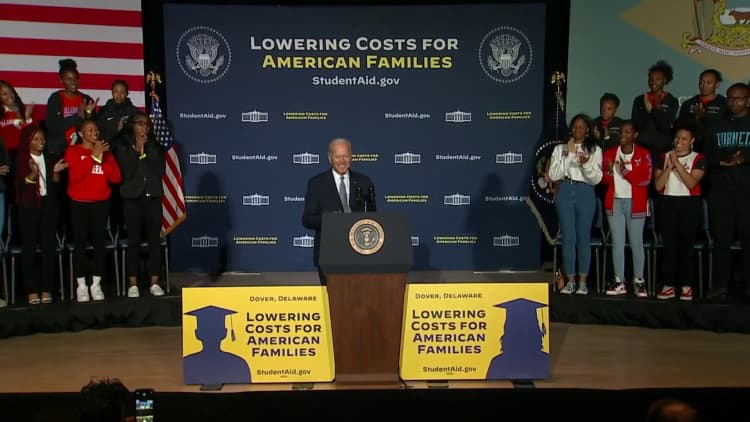HOUSTON, TEXAS – AUGUST 29: Students study in the Rice University Library on August 29, 2022 in Houston, Texas.
Brandon Bell | Getty Images News | Getty Images
After President Joe Biden’s historic announcement that tens of millions of Americans would get up to $20,000 in student loan forgiveness, borrowers’ celebrations were short-lived.
Conservative groups and Republicans soon brought a number of legal challenges against the president’s plan, arguing that the policy was unfair and an overreach of executive authority. Two of those lawsuits have been successful in halting the Biden administration from canceling hundreds of billions of dollars in student debt. In February, the U.S. Supreme Court will have the final say on if the plan can proceed or not.
The disappointment and financial distress that borrowers will feel if Biden’s forgiveness plan is struck down — a likely outcome, according to experts — is likely to be massive.
More from Personal Finance:
Tax ‘refunds may be smaller in 2023,’ warns IRS
IRS warns taxpayers about new $600 threshold for third-party payment reporting
Here’s how to prepare for a 1099-K for Venmo, PayPal payments — and slash taxes
A group of borrower advocacy groups, in a recent brief to the highest court, said student debt forgiveness was essential to the country’s recovery from the public health crisis, which exacerbated the financial difficulties for “borrowers who have, for decades, been at the mercy of a broken student loan system.” Without the cancellation, they warned, “working and middle-class borrowers are at substantial risk of default.”
If that is the way things go, however, here are four of the other relief options for struggling borrowers.
1. Defer payments (once they resume)
The pandemic-era policy suspending federal student loan payments and the accrual of interest is still active. The U.S. Department of Education has said borrowers won’t need to start making payments on their debt again until 60 days after the litigation around its forgiveness plan resolves.
If the lawsuits are still pending at the end of June, the bills will resume 60 days after that, at the end of August.
If you’re unemployed or dealing with another financial hardship at that time, you can put in a request for an economic hardship or unemployment deferment. Those are the ideal ways to postpone your federal student loan payments, because interest doesn’t accrue.
If you don’t qualify for either, though, you can use a forbearance to continue suspending your bills. Just keep in mind that with forbearance, interest will rack up and your balance will be larger — possibly much larger — when you resume paying.
2. Use the Public Service Loan Forgiveness program
The Biden administration has recently made a number of improvements to the Public Service Loan Forgiveness program, which allows those who work for the government and certain nonprofits to get their debt cleared after a decade of payments.
There are typically three primary requirements for public service loan forgiveness, although the recent changes provide some more wiggle room in certain cases:
- Your employer must be a government organization at any level, a 501(c)(3) not-for-profit organization or some other type of not-for-profit organization that provides public service.
- Your loans must be federal Direct loans.
- To reach forgiveness, you need to have made 120 qualifying, on-time payments in an income-driven repayment plan or the standard repayment plan.
The best way to find out if your job qualifies as public service is to fill out the so-called employer certification form.
In 2013, the Consumer Financial Protection Bureau estimated that 1 in 4 American workers could be eligible for the program.
3. Find a more affordable repayment plan
If you find your student loan payments too high when the bills resume, you should explore the different income-driven repayment plans. These programs aim to make borrowers’ payments more affordable by capping their monthly bills at a percentage of their discretionary income and forgiving any of their remaining debt after 20 or 25 years.
To determine how much your monthly bill would be under different plans, use one of the calculators at Studentaid.gov or Freestudentloanadvice.org, said Betsy Mayotte, president of The Institute of Student Loan Advisors, a nonprofit.

If you do decide to change your repayment plan, Mayotte recommends submitting that application to your servicer well ahead of the timeline for payments to restart. Lenders will likely be overwhelmed when they have to begin collecting loan payments from tens of millions of people again.
“I have significant concerns that there will be some big servicing delays,” Mayotte said.
4. File for bankruptcy protection
Currently, it’s difficult, if not impossible, for someone to walk away from their federal student debt in a normal bankruptcy proceeding.
“The new rules do give some hope to federal loan borrowers who may be struggling with their loans for 10 years or more,” Mayotte said.
The federal government will be less likely to object to borrowers’ attempts at discharging their debt, she said, if they have a record of making an effort to repay their student loans but don’t have a high enough income to cover the bill while also meeting their basic needs.
 EU News Digest Latest News & Updates
EU News Digest Latest News & Updates



